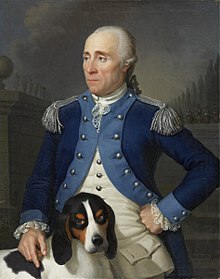Schweizer Laufhund
| Schweizer Laufhund | |||||||||||||||
|---|---|---|---|---|---|---|---|---|---|---|---|---|---|---|---|
 A Schweizer Laufhund of the Schwyz hound variety | |||||||||||||||
| Other names | Chien Courant Suisse, Swiss Hound, Swiss beagle, Swiss running hound, Swiss walking dog | ||||||||||||||
| Origin | Switzerland | ||||||||||||||
| |||||||||||||||
| |||||||||||||||
| Dog (domestic dog) | |||||||||||||||
The Schweizer Laufhund (German: Schweizer Laufhund, lit. 'Swiss running dog') is a group of overlapping scenthounds, originating from Switzerland. The breed has several different varieties.
History

Swiss hounds are known to have existed in Switzerland as early as the first century.[1] They have been found depicted in mosaics stemming from Roman Helvetia in Avenches.[2] Between the 15th and 18th centuries, the dogs gained popularity with French and Italian hunters for their outstanding

predilection for hunting hares. French scenthounds likely influenced the breed's development as Swiss mercenaries returned to their native Switzerland. Prior to the 1880s, they were considered to be a singular, diverse breed, often referred to as Swiss beagles or Swiss walking hounds. However, in 1881, a distinguished Swiss cynologist evaluated numerous examples and determined that there were 7 distinct Swiss breeds.[3] A standard was established for five varieties in 1889, including the Bernese Hound, Jura Hound, Lucerne Hound, Schwyz Hound, and the Thurgovie hound. However, by 1933 the hound of Thurgovie had disappeared and it was decided to establish a single standard for the four remaining breeds.[4][5] However it is still quite prevalent for cynologists to consider them to be separate distinct breeds.[5]
Description
The Schweizer Laufhund is an excellent and independent hunting dog used to find and follow a scent even through difficult ground including hare, roe deer, fox, and sometimes boar.[5] The collective breeds are known by several names including Chien Courant Suisse and Swiss Hound and generally have the same characteristics regardless of type.[6][2]
Appearance
Schweizer Laufhunds stands between 49–59 centimetres (19–23 in) in males, and 47–57 centimetres (19–22 in) in females.[7] The general appearance is of a hound similar to the Schweizer Niederlaufhund, who the Schweizer Laufhund is generally considered the progenitor of. The head is noble with a friendly and soft expression and a deep chest. The legs are strong with a robust structure. At a calm pace they carry the tail low; when they run it is a bit lifted. The breed has long, drop ears and a long tail.[8]
The coat should be short, smooth, and dense. Some variations have a wire coat, although it is not preferred.[9][10]

Bernese Hound
The Bernese hound is found south of Bern, the capital of Switzerland. It is also called the Berner hound, Bernese scenthound, or Berner Laufhund. It is white, black and tan in color.[4][11]

Jura Hound
The Jura hound is found along the Jura region along the French-Swiss border and sometimes it is considered to be a French dog. This breed is also known as the Bruno Jura hound. This type usually has a two-tone brown[10] or black and tan.[11]

Lucerne Hound
The Lucerne hound is found in the region around Lucerne. This type may also be known as the Lucernese hound or Luzerner laufhund. It has a smooth, short coat with a “blue” appearance that is a result of a combination of back hairs and white hairs, very heavily speckled; with black patches or black saddle.[11][10]
Schwyz Hound

The Schwyz hound is found in the Schwyz region. They may also be called the Schwyzer Laufhund, the Swiss hound, or the Swiss laufhund. This type has a smooth coat in white with reddish-orange colored spots. This variation is quite rare. [11][12]
Temperament
The laufhund has a great sense of smell; they are fast, agile, and passionate hunters with great endurance and are able to track various game by scent independently of the hunter.[2]
See also
Notes
- ^ Reinhardt 1912, p. 19.
- ^ a b c "Der Laufhund" [The Running Dog]. Schweizerischer Laufhundeclub [Swiss Running Dog Club]. Retrieved 2023-12-09.
- ^ Jungklaus 1921, p. 11.
- ^ a b Morris 2002, p. 93.
- ^ a b c FCI-Standard N° 59 2002, p. 2.
- ^ FCI-Standard N° 59 2002, p. 1.
- ^ FCI-Standard N° 59 2002, p. 9.
- ^ FCI-Standard N° 59 2002, pp. 4–5.
- ^ FCI-Standard N° 59 2002, p. 10.
- ^ a b c Morris 2002, p. 94.
- ^ a b c d FCI-Standard N° 59 2002, p. 7.
- ^ Morris 2002, p. 95.
References
- "FCI-Standard N° 59 Schweizer Laufhand, Chien Courant Suisse" (PDF), Federation Cynologique Internationale, 2002-06-28
- Jungklaus, Friedrich (1921). Der kleine Münsterländer vorstehhund [The little Münsterlander pointing dog] (in German). J. Neumann.
- Morris, Desmond (2002). Dogs: The Ultimate Dictionary of over 1,000 Breeds. Trafalgar Square Pub. p. 95. ISBN 978-1570762192.
- Reinhardt, Ludwig (1912). Kulturgeschichte der Nutztiere [Cultural history of farm animals] (in German). Vol. 3. E. Reinhardt. p. 22.
External links
![]() Media related to Schweizer Laufhund at Wikimedia Commons
Media related to Schweizer Laufhund at Wikimedia Commons
